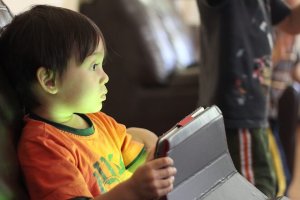Keys to a Balanced Digital Diet for Children

It’s important to make sure your children have a balanced digital diet so that they use technology in a healthy way. The main thing is to take care of interpersonal relationships and make them a priority over technology.
If you establish clear limits and maintain good communication with your children, there’ll be no reason to resort to extremes like banning the internet at home.
These key things we’ve listed below show that all you need is a bit of common sense, quality time with your children, and a critical attitude towards technology.
Why is a balanced digital diet necessary?
Technology has been created to make life easier for us, but digital media is all about the flow of information and constant communication. While this has many advantages, it can also have negative effects on our social lives and personal growth.

The problem starts when children begin to spend more and more time on social networks or other internet sites and miss the chance to interact with people face to face.
As a result, many parents are wondering: “How do I maintain a balanced use of technology ay home, and how can I do this without making it seem like a punishment?”
The trick is to talk in depth with your children about the importance of recognizing that there is life outside the internet!
Keys to a balanced digital diet
1. Find out how dependent your children are on technology
In theory, using technology poses no risk unless it becomes an addiction. This being the case, the first thing you should do is identify how much your children depend on technology.
To do this, turn off your wi-fi at home and ask your children to give you their phone or tablet, etc. Then see how they react. If they get anxious, upset, or irritable then you can be sure they’ve already developed a dependency.
If this has happened, then you’ll need to start gradually taking steps to balance the different aspects of your life: technology, responsibilities, activities, social life, etc.
2. Ban using the phone while eating
To keep a balanced digital diet, you should try to make sure there are at least two hours in the day when you don’t use electronic devices at home.
Many parents choose to do this around lunchtime or dinnertime. This gives you the chance to have good conversations and personal interaction, and still leaves many hours for technology.
It’ll also help teach your children appreciate their food and what you do for them. There’ll be no calls or messages interrupting things, and they can share quality time with the family.
3. Teach them how to be a good speaker and a good listener
This is really important. If they’re good speakers and listeners, then your children will automatically use their phones less, knowing that it’s quite rude not to pay full attention to someone when they’re speaking.

4. Sign your child up to some fun activities
Another good option for keeping a balanced digital diet is to encourage your children to do some after-school activities, such as sports, dance, or music lessons. This way they’ll see that it’s possible to have fun without technology and this will improve their overall well-being.
With music lessons, this will probably require practicing at home. This will also help them spend time doing something other than playing with their phone.
You could even practice with them or ask them to put on a little private concert for you at home. This way they’ll feel supported and valued.
5. Lead by example
If your children see you constantly on your phone or tablet, they’ll end up copying your behavior. It’s really important to set a good example. Be consistent, coherent, and talk with each other to find the best way forward.
It’s important to make sure your children have a balanced digital diet so that they use technology in a healthy way. The main thing is to take care of interpersonal relationships and make them a priority over technology.
If you establish clear limits and maintain good communication with your children, there’ll be no reason to resort to extremes like banning the internet at home.
These key things we’ve listed below show that all you need is a bit of common sense, quality time with your children, and a critical attitude towards technology.
Why is a balanced digital diet necessary?
Technology has been created to make life easier for us, but digital media is all about the flow of information and constant communication. While this has many advantages, it can also have negative effects on our social lives and personal growth.

The problem starts when children begin to spend more and more time on social networks or other internet sites and miss the chance to interact with people face to face.
As a result, many parents are wondering: “How do I maintain a balanced use of technology ay home, and how can I do this without making it seem like a punishment?”
The trick is to talk in depth with your children about the importance of recognizing that there is life outside the internet!
Keys to a balanced digital diet
1. Find out how dependent your children are on technology
In theory, using technology poses no risk unless it becomes an addiction. This being the case, the first thing you should do is identify how much your children depend on technology.
To do this, turn off your wi-fi at home and ask your children to give you their phone or tablet, etc. Then see how they react. If they get anxious, upset, or irritable then you can be sure they’ve already developed a dependency.
If this has happened, then you’ll need to start gradually taking steps to balance the different aspects of your life: technology, responsibilities, activities, social life, etc.
2. Ban using the phone while eating
To keep a balanced digital diet, you should try to make sure there are at least two hours in the day when you don’t use electronic devices at home.
Many parents choose to do this around lunchtime or dinnertime. This gives you the chance to have good conversations and personal interaction, and still leaves many hours for technology.
It’ll also help teach your children appreciate their food and what you do for them. There’ll be no calls or messages interrupting things, and they can share quality time with the family.
3. Teach them how to be a good speaker and a good listener
This is really important. If they’re good speakers and listeners, then your children will automatically use their phones less, knowing that it’s quite rude not to pay full attention to someone when they’re speaking.

4. Sign your child up to some fun activities
Another good option for keeping a balanced digital diet is to encourage your children to do some after-school activities, such as sports, dance, or music lessons. This way they’ll see that it’s possible to have fun without technology and this will improve their overall well-being.
With music lessons, this will probably require practicing at home. This will also help them spend time doing something other than playing with their phone.
You could even practice with them or ask them to put on a little private concert for you at home. This way they’ll feel supported and valued.
5. Lead by example
If your children see you constantly on your phone or tablet, they’ll end up copying your behavior. It’s really important to set a good example. Be consistent, coherent, and talk with each other to find the best way forward.
All cited sources were thoroughly reviewed by our team to ensure their quality, reliability, currency, and validity. The bibliography of this article was considered reliable and of academic or scientific accuracy.
- Ramírez, N., Aguilera, A., Fuentes, C., San Martín, G., & Tapia, C. (2013). La generación net y la dieta digital. Revista educación y tecnología, (3), 228-232. https://dialnet.unirioja.es/descarga/articulo/4620628.pdf
- Nicklas, T. A., O’Neil, C. E., Stuff, J., Goodell, L. S., Liu, Y., & Martin, C. K. (2012). Validity and feasibility of a digital diet estimation method for use with preschool children: a pilot study. Journal of nutrition education and behavior, 44(6), 618-623. https://www.sciencedirect.com/science/article/abs/pii/S149940461100649X
- Orben, A. (2021). Digital Diet: A 21st century approach to understanding digital technologies and development. https://psyarxiv.com/324h8/
This text is provided for informational purposes only and does not replace consultation with a professional. If in doubt, consult your specialist.








